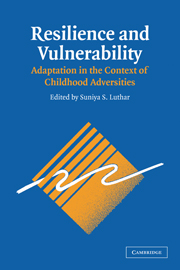Book contents
- Frontmatter
- Contents
- List of Contributors
- Foreword by Dante Cicchetti
- Preface
- 1 A Resilience Framework for Research, Policy, and Practice
- PART I FAMILIAL ADVERSITIES: PARENTAL PSYCHOPATHOLOGY AND FAMILY PROCESSES
- 2 Young Children with Mentally Ill Parents: Resilient Developmental Systems
- 3 Risk and Protective Factors for Children of Depressed Parents
- 4 Resilience and Vulnerability among Sons of Alcoholics: Relationship to Developmental Outcomes between Early Childhood and Adolescence
- 5 Maternal Drug Abuse versus Other Psychological Disturbances: Risks and Resilience among Children
- 6 Resilience to Childhood Adversity: Results of a 21-Year Study
- 7 Sequelae of Child Maltreatment: Vulnerability and Resilience
- 8 Risk and Resilience in Children Coping with Their Parents' Divorce and Remarriage
- 9 Correlational and Experimental Study of Resilience in Children of Divorce and Parentally Bereaved Children
- PART II EXOSYSTEMIC AND SOCIODEMOGRAPHIC RISKS
- PART III COMMENTARIES
- Index
- References
9 - Correlational and Experimental Study of Resilience in Children of Divorce and Parentally Bereaved Children
Published online by Cambridge University Press: 05 June 2012
- Frontmatter
- Contents
- List of Contributors
- Foreword by Dante Cicchetti
- Preface
- 1 A Resilience Framework for Research, Policy, and Practice
- PART I FAMILIAL ADVERSITIES: PARENTAL PSYCHOPATHOLOGY AND FAMILY PROCESSES
- 2 Young Children with Mentally Ill Parents: Resilient Developmental Systems
- 3 Risk and Protective Factors for Children of Depressed Parents
- 4 Resilience and Vulnerability among Sons of Alcoholics: Relationship to Developmental Outcomes between Early Childhood and Adolescence
- 5 Maternal Drug Abuse versus Other Psychological Disturbances: Risks and Resilience among Children
- 6 Resilience to Childhood Adversity: Results of a 21-Year Study
- 7 Sequelae of Child Maltreatment: Vulnerability and Resilience
- 8 Risk and Resilience in Children Coping with Their Parents' Divorce and Remarriage
- 9 Correlational and Experimental Study of Resilience in Children of Divorce and Parentally Bereaved Children
- PART II EXOSYSTEMIC AND SOCIODEMOGRAPHIC RISKS
- PART III COMMENTARIES
- Index
- References
Summary
This chapter presents research on resilience of children and adolescents who have experienced two major disruptions of the nuclear family, parental divorce and parental bereavement. The two research programs share a common research paradigm in which there is an iterative relationship between correlational and experimental studies (Sandler, Wolchik, MacKinnon, Ayers, & Roosa, 1997). Correlational studies are used to identify protective and vulnerability factors, particularly those that may be modifiable by planned interventions. Experimental studies are designed on the basis of the small theory that changing these factors in the desirable direction will promote resilience. Randomized experimental trials of the interventions are conducted to test whether the intervention has changed these vulnerability and protective factors and reduced negative outcomes and whether change in negative outcomes is mediated by change in the vulnerability and protective factors (Sandler et al., 1997). The mediational analysis within the randomized trial provides a stronger test of the causal role of the vulnerability and protective factors to influence negative outcomes than is provided by the correlational studies, and thus contributes to theory about resilience (Rutter, Pickles, Murray, & Eaves, 2001).
The chapter first presents a theoretical framework that specifies alternative models of the influence of vulnerability and protective factors on the resilience of children experiencing significant adversities. We then discuss correlational research on key constructs in the theoretical framework: adversity, and child and family protective and vulnerability factors.
- Type
- Chapter
- Information
- Resilience and VulnerabilityAdaptation in the Context of Childhood Adversities, pp. 213 - 240Publisher: Cambridge University PressPrint publication year: 2003
References
- 21
- Cited by



